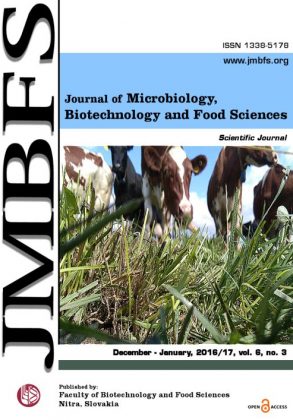INFLUENCE OF GENTAMICIN ON THE SPECIFIC CELL CULTURE (BHK-21) IN VITRO
DOI:
https://doi.org/10.15414/jmbfs.2016/17.6.3.983-986Keywords:
Gentamicin, BHK21, cell morphology, biochemistry, mitochondrial activityAbstract
Gentamicin (GENT) is an aminoglycoside antibiotic commonly used against Gram-negative bacterial infections. GENT is probably the most commonly used antibiotic of all aminoglycosides. The aim of our study was to evaluate the in vitro toxicity of different concentrations of GENT on selected mammalian cell culture (BHK-21 – baby hamster kidney cells). After application of various concentrations of GENT, we controlled the condition of cells in the wells microscopically (magnification x 400). Based on the structure of cells, we evaluated the presence of vital, subvital and dead cells. Cell medium was used for biochemical analyses (Calcium - Ca, Magnesium – Mg, total proteins - TP, Sodium - Na, Potassium - K and Chloride – Cl). Viability of the cells exposed to selected antibiotic in vitro was evaluated using the metabolic activity (MTT) assay. BHK-21 cells were able to survive at a concentration 187.5; 500; 1500; 4500 µg/mL. We found statistically significant decrease (P<0.001) of vital cells in comparison with control in all concentrations of GENT higher than 500 µg/mL. We also found significant increase in the number of subvital and death cells compared to control group in all concentrations of GENT higher than 500 µg/mL. Biochemical parameters observed in the medium were significantly affected in all concentrations of GENT. Content of Na+ and Cl- was the most importantly affected in all observed groups against control group (P<0.001). A statistically significant decrease of Ca (P<0.01) was detected (control vs 937.5 µg/mL resp. 7500 µg/mL of GENT). The mitochondrial activity of the BHK21 cells was significantly (P<0.001) decreased after the administration of all concentrations of GENT when compared to the Control. In conclusion, the exposure of Baby Hamster Kidney fibroblasts (BHK-21) to gentamicin at our concentrations resulted in severe cell damage. Acquired knowledge is possible to apply in toxicity evaluation of pharmacological effective substances in vitro.Downloads
Download data is not yet available.
Downloads
Published
2016-12-01
How to Cite
KováÄik, A., TuÅ¡imová, E., Tvrdá, E., Fülöpová, D., ÄŒupka, P., Tirpák, F., Zbyňovská, K., Massányi, P., & Kolesárová, A. (2016). INFLUENCE OF GENTAMICIN ON THE SPECIFIC CELL CULTURE (BHK-21) IN VITRO. Journal of Microbiology, Biotechnology and Food Sciences, 6(3), 983–986. https://doi.org/10.15414/jmbfs.2016/17.6.3.983-986
Issue
Section
Biotechnology
License
Copyright (c) 2016 Anton KováÄik, Eva TuÅ¡imová, Eva Tvrdá, Diana Fülöpová, Peter ÄŒupka, Filip Tirpák, KatarÃÂna Zbyňovská, Peter Massányi, Adriana Kolesárová

This work is licensed under a Creative Commons Attribution 4.0 International License.
All papers published in the Journal of Microbiology, Biotechnology and Food Sciences are published under a CC-BY licence (CC-BY 4.0). Published materials can be shared (copy and redistribute the material in any medium or format) and adapted (remix, transform, and build upon the material for any purpose, even commercially) with specifying the author(s).





